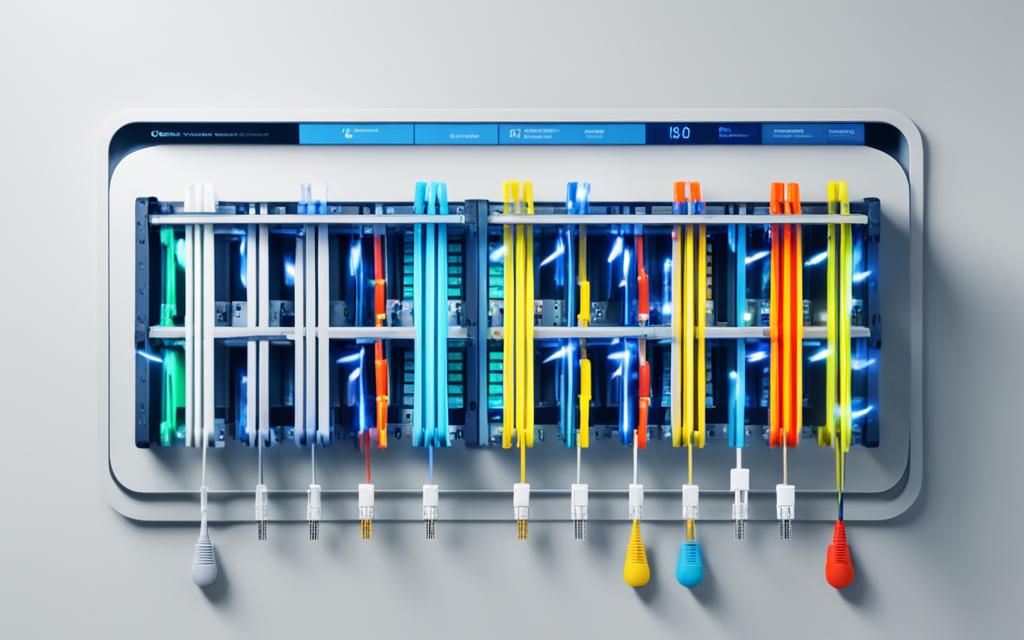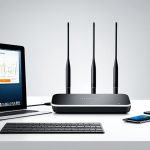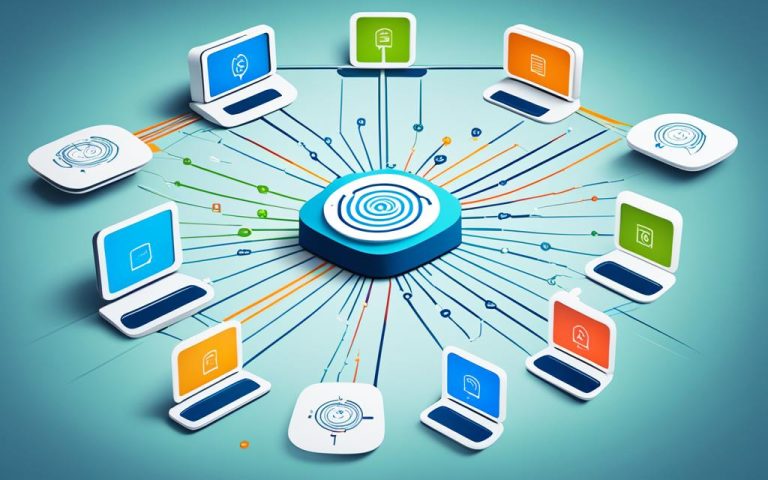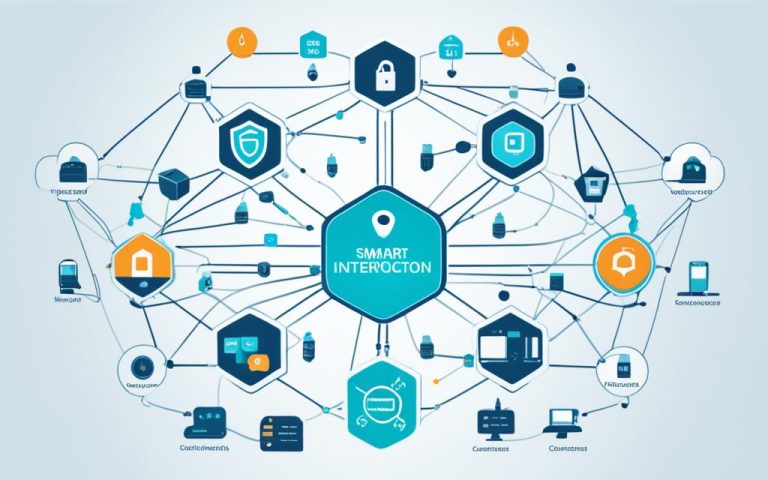Personal Area Networks (PANs) are revolutionizing the way we connect electronic devices within a short range. From smartphones and tablets to laptops and printers, PANs are transforming the way we work and communicate. The future of PAN technology holds numerous exciting possibilities, driving advancements and innovations in PAN network technologies.
PANs are powered by cutting-edge wireless and wired mediums, providing seamless and efficient connectivity. Bluetooth technology is a key component of many PANs, offering quick and cable-free connections between devices.
As PANs continue to evolve, we can expect exciting trends and innovations. The integration of Body Area Networks (BANs) for health monitoring will offer real-time insights into our well-being. Advancements in IEEE standards will enhance PAN network capabilities, ensuring faster and more reliable connections. Moreover, PANs will play a crucial role in the Internet of Things (IoT), connecting devices and enabling seamless communication in a smart and interconnected world.
Join us as we explore the future of PANs, uncovering the latest trends and innovations that will shape the way we live and work. Discover how PANs are poised to revolutionize connectivity and redefine the possibilities of technology.
Defining Personal Area Network (PAN) and Its Core Components
A Personal Area Network (PAN) is a network that enables the connection of electronic devices within a limited range, typically around an individual’s workspace. This allows for seamless communication and data exchange between devices, providing convenient connectivity.
PANs consist of several core components that work together to facilitate efficient network operations:
- Devices: PANs connect a wide range of electronic devices such as smartphones, wearables, and computers. These devices form the foundation of the PAN network, enabling users to perform various tasks and share resources efficiently.
- Connectivity Medium: PANs rely on different connectivity mediums to establish connections between devices. This includes wireless technologies like Bluetooth and Wi-Fi, as well as wired options such as USB cables. The choice of connectivity medium depends on the specific requirements of the PAN network.
- Data Transmission Protocol: PANs utilize specific data transmission protocols to ensure efficient and secure communication between devices. These protocols enable the transfer of data and resources seamlessly, ensuring smooth network operations.
- Network Security Measures: PANs implement various security measures to protect data and network integrity. These measures include encryption, authentication mechanisms, and firewalls to safeguard against unauthorized access and potential threats.
The core components of PANs work in harmony to provide users with convenient connectivity and efficient data exchange. The integration of devices, connectivity mediums, data transmission protocols, and security measures ensures a seamless PAN network experience.
The Role of Bluetooth in Personal Area Networks
Bluetooth technology plays a crucial role in many Personal Area Networks (PANs), offering a wireless method to connect devices over short distances. It is ideal for quick, cable-free connections between devices like smartphones, laptops, and peripherals such as keyboards and headsets. Bluetooth enables seamless communication and synchronization between devices within a PAN network.
With Bluetooth technology, PAN connectivity becomes effortless and convenient. The wireless nature of Bluetooth eliminates the need for physical cables, providing a clutter-free and flexible network environment. This makes it easier for individuals to connect and collaborate across devices within their personal workspace or small area.
In a PAN setup, Bluetooth allows users to establish connections between multiple devices simultaneously. For example, a person can connect their smartphone, laptop, and wireless headset to exchange data, make calls, and listen to audio seamlessly. The ability of Bluetooth to handle multiple connections within a PAN network enhances productivity and facilitates multitasking.
Moreover, Bluetooth offers secure and reliable data transmission within PANs. It utilizes encryption techniques and authentication protocols to safeguard the transmitted data, ensuring privacy and preventing unauthorized access. This makes Bluetooth a trusted solution for PANs that handle sensitive information.
“Bluetooth technology revolutionizes the way devices communicate within Personal Area Networks. Its wireless capabilities enable seamless connections and data synchronization, providing users with a convenient and efficient network experience.” – Mark Johnson, Networking Expert
By leveraging Bluetooth technology, PANs enable individuals to connect and utilize a wide range of devices with ease. Whether it’s transferring files between a smartphone and a laptop or using a wireless keyboard and mouse to enhance productivity, Bluetooth enhances the capabilities of PANs and empowers users with greater flexibility and mobility.
As PANs continue to evolve and integrate with other technologies, Bluetooth remains a vital component, ensuring seamless connectivity and efficient data exchange. Its compatibility with various devices and its widespread adoption make Bluetooth technology a cornerstone of wireless PANs.
With Bluetooth technology as the backbone, wireless PANs offer unmatched convenience and versatility. The ability to connect and synchronize devices wirelessly within a short range brings numerous benefits to individuals and businesses alike.
Advantages of Bluetooth in PANs:
- Wireless and cable-free connectivity
- Compatibility with a wide range of devices
- Secure data transmission and privacy
- Efficient multitasking with multiple device connections
- Enhanced productivity and collaboration
Beyond its current capabilities, Bluetooth technology continues to evolve, with advancements in speed, range, and power efficiency. These developments open up exciting possibilities for the future of PANs and their integration with emerging technologies like the Internet of Things (IoT) and smart devices.
Wireless vs. Wired PANs: Differences in Connectivity
Personal Area Networks (PANs) can be classified into two categories based on their connectivity methods: wireless PANs and wired PANs.
Wireless PANs
Wireless PANs utilize technologies such as Bluetooth and Wi-Fi to establish connections between devices. These wireless technologies offer several advantages:
- Mobility: Wireless PANs provide the freedom to move around without being constrained by cables. This is particularly beneficial in dynamic work environments or when using portable devices.
- Cable-Free: By eliminating the need for physical cables, wireless PANs reduce clutter and enable a clean and organized workspace.
- Easy Setup: Setting up a wireless PAN is often straightforward and hassle-free compared to the complexities involved in routing physical cables for a wired PAN.
Wired PANs
Wired PANs, on the other hand, rely on physical cables such as USB or Ethernet for connectivity. The use of wired connections offers distinct advantages:
- Faster Data Transfer: Wired PANs generally provide faster data transfer rates compared to wireless PANs. This is crucial when dealing with large files or real-time streaming applications that require seamless and high-speed data transmission.
- Stability: Wired connections often offer a more stable and reliable connection, minimizing the potential for interference or signal loss that can occur in wireless environments.
- Security: Wired PANs can provide enhanced security measures due to the physical nature of the connection, making it harder for unauthorized access to the network.
The choice between wireless and wired PANs depends on the specific requirements of the network. Factors to consider when making this decision include the need for mobility, data transfer speed, reliability, and security.
To further understand the differences, refer to the table below:
| Wireless PANs | Wired PANs |
|---|---|
| Utilizes technologies like Bluetooth and Wi-Fi | Relies on physical cables such as USB or Ethernet |
| Offers mobility and eliminates cable clutter | Provides faster data transfer rates |
| Easy to set up | Provides a stable and reliable connection |
| May have security vulnerabilities | Offers enhanced security measures |

Understanding the differences between wireless and wired PANs enables organizations to make informed decisions when it comes to implementing a PAN network that best suits their needs.
Integrating Body Area Network (BAN) with Personal Area Network
Body Area Networks (BANs) are networks that utilize sensors placed on or inside the human body to monitor various health metrics, providing valuable insights into an individual’s well-being. Integrating BANs with Personal Area Networks (PANs) unlocks the potential for real-time health monitoring and personalized healthcare services, revolutionizing the way we approach healthcare.
By combining BANs with PANs, individuals can benefit from continuous monitoring of vital signs and other health parameters. This real-time data allows for the early detection of health issues, enabling timely intervention and prevention of further complications.
In a business setting, the integration of BANs and PANs opens up exciting possibilities for enhancing employee health programs. Employers can offer personalized wellness plans, leveraging the data collected from BANs to provide targeted recommendations and preventive measures. This approach promotes employee well-being, leading to increased productivity and reduced healthcare costs.
In sectors like hospitality, the integration of BANs with PANs can provide innovative guest services. Guests can have access to personalized healthcare services during their stay, ensuring a pleasant and healthy experience. This integration enables hotels and resorts to differentiate themselves by offering a unique and holistic approach to guest well-being.
The Applications of PAN and BAN Integration
The combination of PAN and BAN technologies holds promise for various applications in healthcare, wellness, and personal tracking. Some notable applications include:
- Remote patient monitoring: Patients can receive personalized healthcare services from the comfort of their homes, reducing hospital visits and allowing for more efficient healthcare delivery.
- Sports and fitness tracking: Athletes and fitness enthusiasts can leverage PAN and BAN integration to monitor their performance, track vital signs, and optimize their training routines.
- Elderly care: BANs integrated with PANs enable continuous health monitoring for seniors, ensuring their well-being and providing timely assistance in case of emergencies.
- Chronic disease management: Patients with chronic conditions can benefit from continuous monitoring and personalized care plans, improving their quality of life and reducing the risk of complications.
Overall, the integration of Body Area Networks with Personal Area Networks represents a significant advancement in healthcare technology. It empowers individuals with real-time health monitoring, facilitates personalized healthcare services, and opens up a wide range of applications in various sectors. The future of healthcare is personalized, connected, and accessible, thanks to the seamless integration of BANs and PANs.
Conclusion
Personal Area Networks (PANs) are poised to revolutionize connectivity for businesses and individuals, shaping the future of technology. With advancements like the integration of Body Area Networks (BANs), developments in IEEE standards, and their vital role in the Internet of Things (IoT), PANs are constantly evolving.
PANs offer the convenience of connecting devices within a short range, enabling seamless data exchange and resource sharing. Bluetooth technology, a key component of many PANs, provides wireless connectivity, removing the need for cables and enhancing mobility.
Wireless PANs offer advantages like mobility, while wired PANs deliver faster data transfer rates and more stable connections. Both types cater to specific requirements and preferences, ensuring adaptability to various business needs.
The future of PANs holds tremendous potential. Integrating BANs opens up new possibilities for real-time health monitoring and personalized healthcare services. PANs, together with advancements in IEEE standards, will play a pivotal role in the IoT ecosystem, further driving PAN network evolution.
FAQ
What is a Personal Area Network (PAN)?
A Personal Area Network (PAN) is a network that connects electronic devices within a short range, typically around an individual’s workspace. It consists of devices like smartphones, wearables, and computers, connected through wireless or wired mediums.
How does Bluetooth technology contribute to PANs?
Bluetooth technology plays a crucial role in PANs by providing a wireless method to connect devices over short distances. It enables quick, cable-free connections between devices like smartphones, laptops, and peripherals.
What are the advantages of PANs over wired and wireless connections?
PANs offer advantages like mobility, ease of use, and adaptability to specific business needs. They facilitate tasks such as file sharing, internet access, and device synchronization within a short range, typically up to 10 meters.
How are wireless and wired PANs different?
Wireless PANs use technologies like Bluetooth and Wi-Fi, providing mobility and eliminating the clutter of cables. Wired PANs rely on physical cables like USB or Ethernet, offering faster data transfer rates and more stable connections.
What is the potential of integrating Body Area Networks (BANs) with PANs?
Integrating BANs with PANs opens up possibilities for real-time health monitoring and personalized healthcare services. This combination holds promise for various applications in healthcare, wellness, and personal tracking.
How do PANs contribute to the future of connectivity?
PANs are evolving with advancements like the integration of BANs, developments in IEEE standards, and their role in the Internet of Things (IoT). They offer convenience and facilitate data exchange and resource sharing within a short range.



















